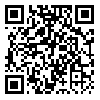Volume 9, Issue 3 (6-2022)
jbrms 2022, 9(3): 31-41 |
Back to browse issues page
Department of Biochemistry, Biophysics and Genetics, Medical College, Mazandaran University of Medical Sciences, Sari 48157-33971, Iran , tpourfallah@gmail.com
Abstract: (1406 Views)
Introduction: In this research, a new material (Ti2V0.7Cu97.3) was proposed for the target of medical linear accelerators (linacs) to reduce the production of unwanted photoneutrons in the radiotherapy. So, the fluence, dose equivalent and kerma of the photoneutrons were calculated in a soft tissue phantom.
Materials and Methods: The medical linac was the Varian 2100 C/D 18 MV, which its tungsten target was replaced with a new multi-metal target (Ti2V0.7Cu97.3). Desired quantities were computed in a ICRU soft tissue phantom, using the Monte Carlo code MCNPX (v. 2.6).
Results: The ratio of the maximums of fluence, kerma, and dose equivalent of photoneutrons along the central axis of the ICRU phantom with new target rather than tungsten target were 72 %, 59 % and 61 %, respectively. Average of the Ratio of fluence, kerma, and dose equivalent in inner area (distances less than 5 cm from central axis) at different depths of the phantom with new target rather than tungsten target were 78 %, 70 % and 75 %, respectively. Uncertainties at all points were less than 5 % (except for a few points which were less than 10 %).
Conclusion: This work showed that applying Ti2V0.7Cu97.3 alloy for the target of linac, can reduce the produced photoneutrons up to 38 % by an applicable and inexpensive way.
Materials and Methods: The medical linac was the Varian 2100 C/D 18 MV, which its tungsten target was replaced with a new multi-metal target (Ti2V0.7Cu97.3). Desired quantities were computed in a ICRU soft tissue phantom, using the Monte Carlo code MCNPX (v. 2.6).
Results: The ratio of the maximums of fluence, kerma, and dose equivalent of photoneutrons along the central axis of the ICRU phantom with new target rather than tungsten target were 72 %, 59 % and 61 %, respectively. Average of the Ratio of fluence, kerma, and dose equivalent in inner area (distances less than 5 cm from central axis) at different depths of the phantom with new target rather than tungsten target were 78 %, 70 % and 75 %, respectively. Uncertainties at all points were less than 5 % (except for a few points which were less than 10 %).
Conclusion: This work showed that applying Ti2V0.7Cu97.3 alloy for the target of linac, can reduce the produced photoneutrons up to 38 % by an applicable and inexpensive way.
Type of Study: Research |
Subject:
Medical physics
Received: 2022/03/30 | Accepted: 2022/05/18 | Published: 2022/06/19
Received: 2022/03/30 | Accepted: 2022/05/18 | Published: 2022/06/19
| Rights and permissions | |
 |
This work is licensed under a Creative Commons Attribution-NonCommercial 4.0 International License. |



